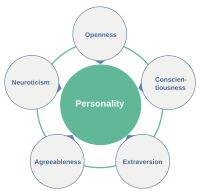
Photo from wikipedia
Herding is ubiquitous throughout all social life forms, providing beneficial outcomes. Here, we examine whether herding emerges spontaneously in human groups and whether it adheres to the core principles of… Click to show full abstract
Herding is ubiquitous throughout all social life forms, providing beneficial outcomes. Here, we examine whether herding emerges spontaneously in human groups and whether it adheres to the core principles of herding observed in the animal kingdom. Using a computerized paradigm involving the movements of circles, we tested the emergence of spontaneous and intentional herding of 136 participants assigned into groups of four participants. Herding was assessed by measuring directional synchrony in the movements of the circles, level of cohesion, and separation between circles. We found that human groups tend to spontaneously herd, particularly in terms of directional synchrony, supporting the notion of a human herding instinct. We further asked whether individuals with high traits of Autism Spectrum Disorder (ASD) exhibit differences in their herding tendencies. Results indicated that individuals with high ASD traits showed greater social separation from the group, compared to individuals with low ASD traits. Moreover, we found diminished spontaneous synchrony, but intact instructed synchrony in the high vs. the low ASD traits group. We contend that humans spontaneously herd with their group and suggest that the spontaneous tendency to synchronize with others is diminished in individuals with high ASD traits, though it is recovered when synchronization is intentional.
Journal Title: Scientific Reports
Year Published: 2020
Link to full text (if available)
Share on Social Media: Sign Up to like & get
recommendations!